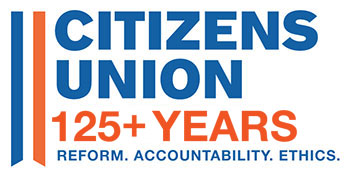Originally Published: December 14, 2010
Urges ending partisan gerrymandering and removing the legislative conflict of self interest in drawing district lines
New, Strongly Defined Criteria is Also Essential to any Redistricting Reform
Citizens Union today advocated for the creation of an independent commission to draw the lines for congressional and state legislative districts in testimony at a State Senate hearing on redistricting reform.
“While we commend the State Senate for seeking public input regarding redistricting reform, action is needed to end the current system of partisan gerrymandering,” said Dick Dadey, Executive Director of Citizens Union. “New Yorkers – as well a majority of state legislators from both houses and across the aisle – overwhelmingly support the creation of an independent citizens redistricting commission. In drawing their own district lines, legislators have a conflict of self-interest in the process which needs to end. Experience has shown that legislators will draw lines to maximize their ability to get reelected even if it results in strangely shaped districts that divide communities and diminish accountability to the general public.”
Pointing to the bill S.1614-B/A.5279-B carried by state legislators Mike Gianaris and David Valesky as the best model, which has undergone revisions to build support for the bill, Citizens Union called for a commission whose members would be selected through a two-step filtering process that would distance those drawing the lines from the legislators who have an inherent conflict of interest in participating in the process. Elected officials, staff of elective officials, lobbyists, partisan governmental or political party appointees, and those holding such positions in the last two years along with relatives of elected officials would be prevented from serving on the independent apportionment commission determining the shape of legislators’ districts.
An independent commission is just one of three components of comprehensive redistricting reform emphasized by Citizens Union. Citizens Union also made recommendations for specific criteria for drawing lines that will help ensure that district shapes serve the public interest rather than the legislators’ goal of eliminating any challenge to their own reelection.
“It is critical for any redistricting reform to narrow the difference in population between the largest and smallest districts,” said Alex Camarda, Director of Public Policy and Advocacy. “The current margin of ten percent between state legislative districts gives legislators the space to draw boundaries that serve their own reelection. Making districts virtually the same size in population will limit the opportunity to gerrymander.”
Citizens Union also stressed that districts should be compact, strive to align with political subdivisions like counties, boroughs or villages, and not be drawn to deliberately discourage political competition or deny or abridge the voting rights of minorities.
Citizens Union also noted that any redistricting map should go through a robust public vetting process before it is approved by the legislature and the governor.
“The public must have ample opportunity to weigh in on the lines that are drawn before they are finalized,” said Rachael Fauss, Policy and Research Manager at Citizens Union. “Multiple hearings should be held across the state and the public should have access to all the tools those drawing the lines have including mapmaking software and relevant census and other data.”
Citizens Union has long sought redistricting reform, most recently beginning in 2005, working to draft the Valesky/Gianaris bill, evaluating candidates in the 2010 elections in part based on their commitment to independent redistricting, and working with Mayor Koch to launch NY Uprising.
